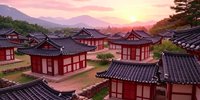Korean Dynasty Timeline: From Three Kingdoms to Joseon
3 minute read

Korean history is a series of periods that shaped the nation’s culture, politics, and society. From the Three Kingdoms, the Joseon Dynasty, Goryeo Dynasty, Silla, to the modern division of North and South Korea, each era has unique features and historical moments. This blog post covers the timeline of Korea’s historical periods, focusing on key events and cultural markers.
Three Kingdoms Period (57–668)
The Three Kingdoms Period (57-668), involved Goguryeo, Baekje, and Silla, alongside Gaya. These states competed for the peninsula.
Goguryeo’s tomb murals, found in present-day North Korea, show detailed art and mythology. Baekje crafted fine gold jewelry and built the Mireuksa Temple. Silla used a bone-rank system to structure society. This system organized people based on their family’s closeness to the royal line, determining their social status and roles in government.
Buddhism grew, with temples like Hwangnyongsa in Silla serving as centers for learning and worship. This era shaped early Korean identity, blending local traditions with Chinese influences.
Silla Dynasty (668–935)
The Silla Dynasty (668-935) or Unified Silla Period, began when Silla, with help from Tang China, defeated Baekje and Goguryeo to unify the peninsula. Gyeongju, the capital, was a major city with many historical sites. Bulguksa Temple and Seokguram Grotto, both UNESCO World Heritage Sites, feature detailed stone carvings and Buddha statues.
Cheomseongdae, an astronomical observatory in Gyeongju, shows Silla’s scientific progress. The period saw cultural growth, but internal conflicts and rebellions weakened Silla, leading to the Later Three Kingdoms.
Later Three Kingdoms Period (892–936)
The Later Three Kingdoms Period (892-936), was a time of division. Later Baekje, Later Goguryeo (Taebong), and a weakened Silla fought for power. Warfare and shifting alliances defined this era. Wang Geon, founder of the Goryeo Dynasty, unified the peninsula in 936, ending the conflict. This period, though short, saw military developments and set the stage for Goryeo’s rule, which gave the name “Korea.”
Goryeo Dynasty (918–1392)
The Goryeo Dynasty (918-1392), was a time of cultural growth. Goryeo artisans made celadon pottery with a jade-green glaze, admired worldwide. The Tripitaka Koreana, Buddhist scriptures carved on wooden blocks, was created and stored at Haeinsa Temple, a UNESCO World Heritage Site. Kaesong, the capital, was a hub for trade and diplomacy. Despite Mongol invasions and internal issues, Goryeo’s achievements in art and religion left a lasting legacy.
Joseon Dynasty (1392–1897)
The Joseon Dynasty (1392-1897), was Korea’s longest dynasty, led by Confucian principles. Founded by Yi Seong-gye, it built Gyeongbokgung Palace, a key example of traditional architecture. King Sejong the Great created Hangul, the Korean alphabet, in 1443, making reading and writing easier for all. Joseon’s isolationist stance earned it the “Hermit Kingdom” nickname, but it produced innovations like the rain gauge and turtle ships, early armored warships. External pressures led to its end with Japanese annexation in 1910.
Japanese Colonial Period (1910–1945)
The Japanese Colonial Period (1910-1945), was a time of hardship. Japan banned the Korean language and targeted cultural sites like Buddhist temples to erase Korean identity. The March 1st Movement in 1919, a nationwide protest, showed strong resistance and boosted national pride. Japan’s defeat in World War II ended the occupation. This period’s legacy of resistance remains a key part of Korean history.
Post-Liberation and Division (1945–Present)
The Post-Liberation and Division era (1945-today), began with Korea’s split into North and South, followed by the Korean War (1950–1953). South Korea grew from poverty to a global economy, called the “Miracle on the Han,” with cultural exports like K-pop. The Demilitarized Zone (DMZ) marks the division, while Seoul’s modern skyline shows South Korea’s progress. North Korea, under the Kim family, remains isolated. This era reflects Korea’s resilience and contrasts between the two nations.
These periods form Korea’s rich history, offering much to explore. Sites like Bulguksa Temple or Haeinsa’s Tripitaka Koreana connect visitors to the past. From Gyeongju’s ancient tombs to Seoul’s bustling streets, Korea’s history is a story of growth and endurance.
Read in another language
Most popular articles
Related posts

Experience the life of a Buddhist monk with a temple stay at Haeinsa, one of Korea's Three Jewel Temples. Discover Tripitaka Koreana and learn about Buddhist traditions.

In Yangsan, on the southeastern slopes of Mount Yeongchuksan, you can find Tongdosa Temple. Tongdosa is one of the three jewel temples of Korea and is a significant center of Buddhism in the coun

Hwaeomsa Temple in Jirisan
2 minsExplore Hwaeomsa Temple on Jirisan, founded in 544 and houses national treasures. Experience its history and temple stays in South Jeolla.


